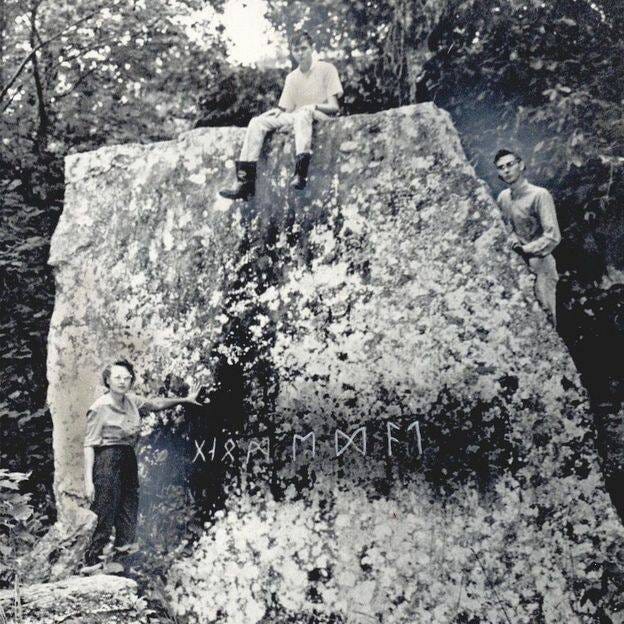In case you haven't heard, there are some highly regarded scholars with theories that Europeans may have visited the Americas BEFORE Columbus. Some call this theory shocking and scandalous, that's mainly because they are either unwilling to review evidence, or they are extremely racist. In fact, that they say anything in Pre Columbus America could only be Native or MesoAmerican in origin. So let's analyze the infamous Heavener Runestone debate, and pick apart the arguments.
Above Gloria Farley and her sons pose with the Heavener Runestone in 1971, in one of the most iconic images of the massive monument. She was among the first American researchers to take an interest in the massive monolith. But, in order to really understand what is happening here, we must find out when was this thing was first discovered, and compare that with the known time frames that those Runes were used. That will help us begin to build a real timeline, and find some logical answers.
The First Documented Sightings.
The earliest mention of the Heavener Oklahoma Runestone, came from the late 1830’s when a group of Choctaw hunters noticed the line of unfamiliar runes. Since then, locals in the area had referred to the monolith as Indian Rock for nearly a century, believing that it must have been Native Americans that made the deeply mysterious inscriptions.
The Choctaw who were relocated into parts of Oklahoma on the forced “Trail Of Tears” march, did not want to populate that particular area. They considered the runestone to be a warning, and later referred to it as being on cursed or sour ground.
French fur trappers came upon it again in 1874, and documented its location. Making them the first Europeans to see it other than a handful of local homesteaders, since the founding of America. Anyways, getting back to the point, this runestone was first located by Choctaw Hunters in 1830’s. Keep the year 1838 in your mind, it important and you will soon understand exactly why.
The First Research
It was not until 1938 that American researcher Gloria Farley began her first investigations into the mysterious origins of this landmark. That is when a Smithsonian scholar recognized the Runes as being similar to the Vikings Younger Futhark. Which was nearly 100 years after its initial native American re-discovery. Her research started the debate on what this stone represented, and who created it. Later in her research, in roughly 1968 scholars from the Smithsonian took over the whole site.
Many of these scholars argue that the Runic Alphabet used on the stone actually predates the Younger Futhark. During the time of Leif Erikson and his well documented voyage to Vindland circa 1002 AD, the well known Viking alphabet the Younger Futhark would have been in usage.
This debate can finally be put to rest now though, as the whole body of evidence will clearly show.
The Runes.
The single word on the Heavener Runestone is quite simple to decipher. The word is etched in Elder Futhark Runes, and says GNOMEDAL. The meaning is “Gnome Valley” and was likely made as a warning to those passing through. Among the Germanic peoples, Gnomes were known as small mischievous beings. They were temperamental and often violent, making this more than a general place marker. It was essentially a “No Trespassing” warning, with your death by “Gnome” being the threat.
The Runes themselves are ancient, being among common usage before 550 AD, and possibly go as far back as 150 BC. The biggest piece of evidence that this particular runestone is not some kind of prank, is when those Ancient Runic Alphabets were first discovered. The knowledge of how to read the Elder Futhark, a runic alphabet used by early Germanic tribes, was lost over time. It was rediscovered and deciphered in 1865, by the Norwegian scholar Sophus Bugge.
Both the Anglo-Saxon futhorc and the Younger Futhark remained in use during the Early and the High Middle Ages respectively. The needed knowledge on how to read the Elder Futhark was forgotten until Bugge in 1865. Thus making it virtually impossible for someone to creat a hoax with the Heavener Runestone inscription before the Choctaw found it in the 1830’s.
Just Use Some Logic
The other runestones in Oklahoma are likely the ones that are faked. Not only are they written in a distinctly different Runic Alphabet, but they also appear to have been carved somewhere in the ballpark of 1930 - 1940, making them the likely hoaxes.
Links and Sources :
https://en.m.wikipedia.org/wiki/Heavener_Runestone_Park
https://www.gloriafarley.com/
https://en.m.wikipedia.org/wiki/Elder_Futhark
https://en.m.wikipedia.org/wiki/Sophus_Bugge
https://g.co/kgs/rkGYHEK







We know that Vikings settled Upper Canada (Newfoundland), but I had no idea that they'd traveled as far as Oklahoma. That's fascinating.
Don't use a portrait of Einstein to underline Logic.